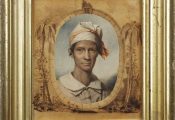Bust of an enslaved African in chains, stamped COPELAND on the reverse, manufactured by W.T. Copeland, after 1847.
This sculpture of an enslaved African was made at least 14 years after slavery was abolished in Britain and its colonies. This shows that many British people supported the continuing campaign to end slavery worldwide. The enslaved African has a collar and chain around his neck. African people were captured to be sold to slave traders. They were chained together and marched in a line to the coast to be sold. The journey could take weeks or months.
This sculpture is made from Parian. Parian is a white, unglazed pottery that looks similar to marble. Figures made from Parian soon became very popular.
© Wilberforce House Museum, Hull Museums
Accession reference: Wilberforce House Museum, Hull Museums, KINCM:1979.113



